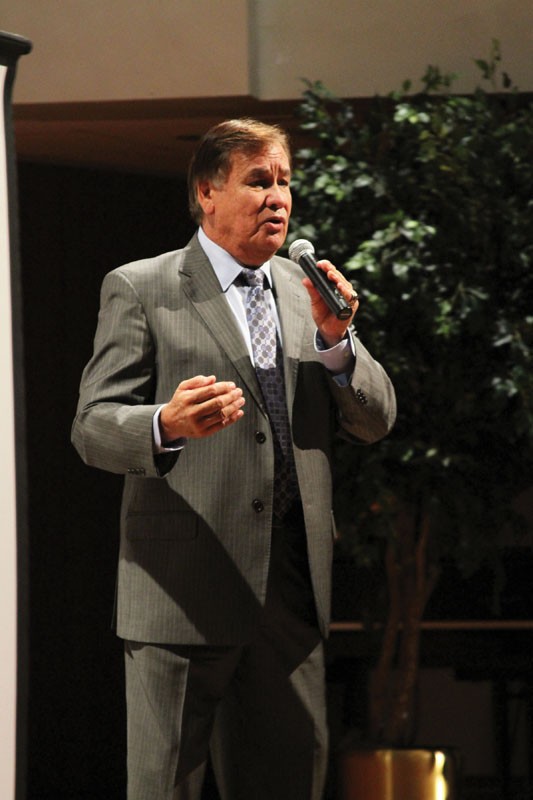Native American Olympic gold medalist speaks for Heritage Month

GVL / Emma Moulton Speaker Billy Mills
Nov 14, 2012
Now 74 years old, Billy Mills doesn’t look like a 10,000-meter runner, let alone the first American to win an Olympic gold medal in the event and the second Native American to win a gold ever. Though Mills was an officer in the U.S. Marine Corps and his 1964 victory is considered “one of the greatest Olympic upsets in history,” Mills’ status as a member of the Oglala Lakota tribe of Native Americans lead to his suffering from racism and disrespect.
These experiences formed the core of the presentation he gave at Grand Valley State University’s Cook-DeWitt Center on Nov. 12. His visit was just one part of GVSU’s Native American Heritage Month, sponsored by the Office of Multicultural Affairs and in conjunction with the Professional of Color Lecture Series.
Before his presentation, “Global Unity,” a short film clip was shown of the last few minutes of the race Mills won in 1964. During the presentation, Mills shared his life story, speaking about what it was like growing up as an orphan on the Pine Ridge Indian Reservation in South Dakota, his decision to attend the University of Kansas on a track scholarship, and many times when he overcame cultural discrimination and blatant racism.
Mills’ presentation included stories about the disrespect afforded him by individuals who assumed that, because he was Native American, he was also an alcoholic and a drug addict.
Accusations to this effect were made about him in public in Barcelona, where Mills was eating dinner with his wife and daughter. A man stood up and said that though he had never met Mills, the man knew Mills was a drunk drug-addict, and continued to say untrue things about Mills.
Mills recalled his daughter’s pleas for him to “say something, Daddy.” Her efforts, combined with Mills’ memories of his father encouraging him as a youth, gave him the strength to stand up and defend himself in a forthright, but respectful manner.
Another striking story involved several times over the period of a few years in which photographers wanted Mills—referred to by one of them as ‘the dark one’—out of the photo. A couple of the photographers took two photos: one with him in it, and another without him.
Overwhelmed by the discrimination and exclusion, Mills knelt on the windowsill of his fourth story window one day, rocking back and forth, trying to convince himself to just let go.
However, Mills did not let go, and today serves as the spokesperson for Running Strong for American Indian Youth, an organization that helps support projects that benefit the American Indian people and their youth. He authored the book “Lessons of a Lakota” and is also the subject of the film Running Brave (1983).
“It’s the journey, not the destination, that empowers us,” he said.
For more information, visit www.gvsu.edu/oma.
[email protected]

























